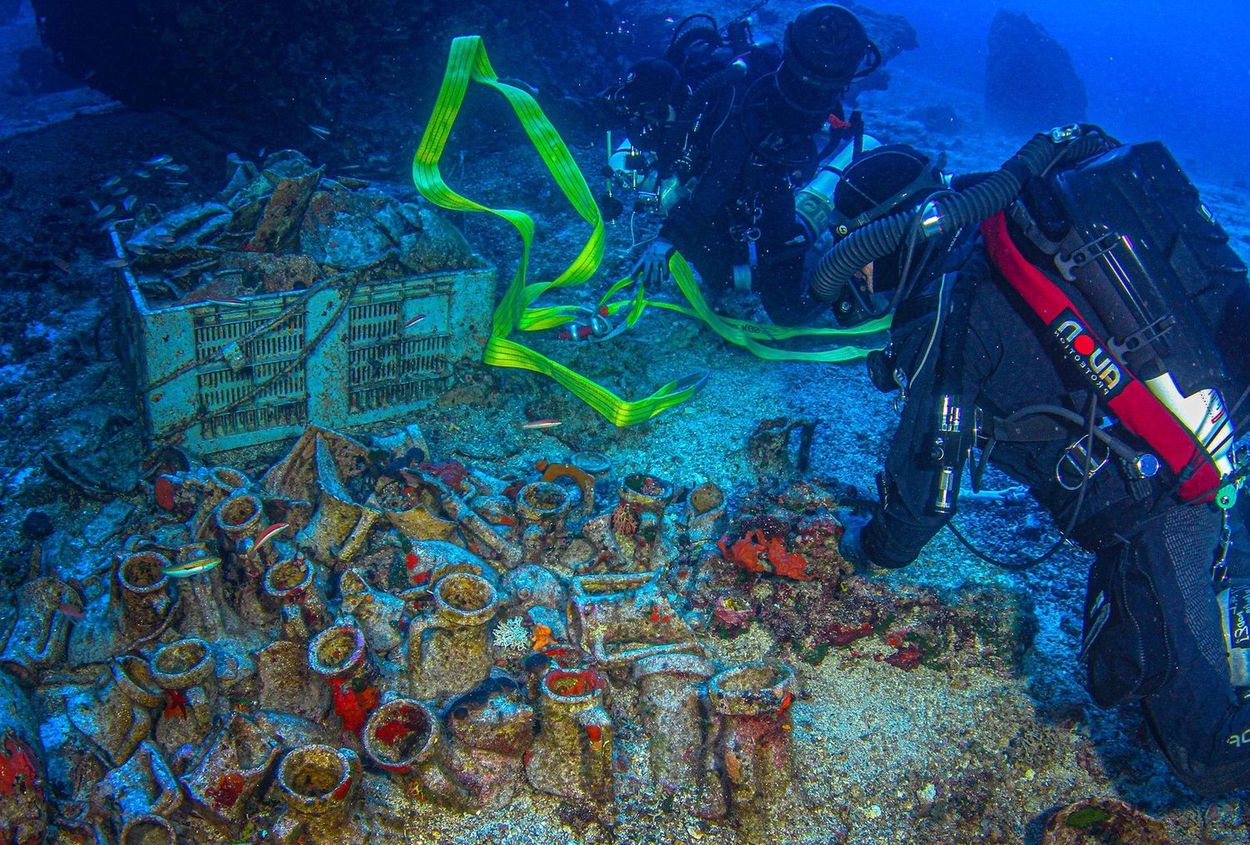
How did an ancient shipwreck change our understanding of Greek technology and culture? The Antikythera shipwreck, discovered by Greek sponge divers in 1900, revealed a treasure trove of artifacts that reshaped our knowledge of ancient civilizations. Found off the Greek island of Antikythera at depths of 40 to 50 meters, this Roman-era cargo ship contained a wealth of items, including bronze and marble statues, pottery, glassware, jewelry, and coins. Among these discoveries was the Antikythera mechanism, a complex device capable of predicting celestial movements and eclipses. Initially ignored, this mechanism later proved to be an ancient computer, showcasing the advanced technological prowess of the Greeks.
Key Takeaways:
- The Antikythera shipwreck, discovered by Greek sponge divers in 1900, revealed ancient artifacts and the world's first analog computer, the Antikythera mechanism, changing our understanding of ancient technology and history.
- Recent research and discoveries continue to shed light on the Antikythera shipwreck, challenging theories about its cargo and the cause of the wreck, while advanced technology and popular culture impact highlight its significance in history.
The Discovery of the Antikythera Shipwreck
The Antikythera shipwreck is a fascinating archaeological find that has captivated historians and scientists alike. Discovered by chance, this ancient wreck has revealed incredible artifacts and mysteries from the past.
-
Discovery: In the spring of 1900, Greek sponge divers stumbled upon the wreck while seeking shelter from a storm near the island of Antikythera. Their accidental find would become one of the most significant underwater discoveries of the 20th century.
-
Depth: The wreck lies at a depth of about 40 to 50 meters (131 to 164 feet) off Point Glyphadia on the Greek island of Antikythera, making it accessible yet challenging for divers.
-
Initial Exploration: The sponge divers initially recovered several large objects, including bronze and marble statues, pottery, unique glassware, jewelry, coins, and the mysterious Antikythera mechanism.
-
Captain Kontos: Captain Dimitrios Kontos and his crew played a crucial role in the initial discovery and recovery efforts. They informed Greek officials, leading to a naval expedition to support the recovery.
Excavation and Artifacts
The excavation of the Antikythera shipwreck has yielded a treasure trove of artifacts, providing a glimpse into ancient Greek technology and culture.
-
Excavation Efforts: From 1900 to 1902, the Greek navy dispatched two ships to support the recovery efforts. This initial excavation revealed a wealth of discoveries now housed in Greece's National Archaeological Museum in Athens.
-
Artifacts: Among the artifacts retrieved were three life-size marble horses, jewelry, coins, glassware, and hundreds of works of art, including a seven-foot-tall "colossus" statue of Herakles (Hercules).
-
The Antikythera Mechanism: The most significant discovery was an unassuming lump of bronze later identified as a complex set of interlocking gears capable of predicting celestial movements and eclipses.
-
Initial Ignorance: The Antikythera mechanism was initially ignored for 75 years after its discovery. It wasn't until 1951 that British science historian Derek J. de Solla Price became interested in the device, leading to further investigations.
The Antikythera Mechanism
The Antikythera mechanism is a marvel of ancient engineering, often considered the world's first analog computer.
-
De Solla Price’s Work: In 1971, Price and Greek nuclear physicist Charalampos Karakalos made X-ray and gamma-ray images of the 82 fragments of the mechanism. Price published a paper on their findings in 1974, marking a significant milestone in understanding the device.
-
Complexity: Believed to be an early computer, the mechanism was used to plan important events such as religious rituals, the early Olympic games, and agricultural activities. Its complexity and accuracy have changed our views of ancient technology.
-
Accuracy: The mechanism includes hands or pointers for Mercury, Venus, Mars, Jupiter, and Saturn. Text on the front plate confirms that the planetary motion was modeled mathematically using numerous complex gears, highly accurate to within one degree in 500 years.
Theories and Recent Research
Theories about the ship's cargo and recent research continue to shed light on the Antikythera shipwreck's history and significance.
-
Transportation Theories: One theory suggests the mechanism was headed to Rome for a triumphal parade for Emperor Julius Caesar in the 1st century BCE. Another theory suggests it was carrying booty from the Roman general Sulla’s sack of Athens in 87–86 BCE.
-
Recent Research: More recent research suggests the ship may have been en route to Rome from Turkey. The ship’s path has been difficult to trace because the Aegean was a busy shipping area at this time.
-
Multiple Shipwrecks: There is speculation about the possibility of multiple shipwrecks in the area. In 2012, marine archaeologists found evidence of a second wreck about 800 feet to the south, revealing an anchor and containers similar to those found on the original ship.
Challenges and Advanced Technology
Excavating the Antikythera shipwreck presents numerous challenges, requiring advanced technology and innovative solutions.
-
Excavation Challenges: The wreck's depth and the presence of large boulders that have fallen from Antikythera’s steep cliffs over 2,000 years make excavation challenging. These boulders likely protected the treasure buried beneath but require advanced technology to lift and move.
-
Advanced Technology: Divers use advanced technology such as underwater balloons designed by Swiss watchmaker Hublot to lift and move the boulders. These balloons are filled with air by a compressor sitting on a ship above, helping to precision-lift the rocks so they can be moved to the sea floor.
Recent Finds and Historical Context
Recent discoveries and the historical context of the Antikythera shipwreck provide further insights into this ancient marvel.
-
Recent Finds: Recent surveys have uncovered human teeth, a marble plinth for a statue, a lead collar for an anchor, and the weathered, marble head of a bearded male figure believed to be the Greek hero Hercules (Herakles).
-
Statue Reconstruction: The weathered head may belong to the Herakles of Antikythera statue currently on display in the National Archaeological Museum in Athens. The body of this statue was found in 1901 but its exact location was unknown until the discovery of the head.
-
Historical Context: The Mediterranean was a hive of activity during the first century BC, with vessels of all makes and sizes crisscrossing their way to ports and harbors in Africa, Italy, and the rest of Europe. The island of Antikythera lies at the center of this ancient transport hub despite famously drowning ships.
Speculation and Uncertainty
Speculation about the ship's cargo and the cause of the wreck adds to the intrigue surrounding the Antikythera shipwreck.
-
Speculation on Ship’s Cargo: Speculation has swirled around who may have ordered the "Titanic of ancient times." Some point to famous Romans who would have had the means and power to order a haul of that size. Archaeologist Brendan Foley suspects that if this was the case, the ship may have been loaded up with the spoils of war to be brought back for a victory parade in Rome.
-
Peaceful Situation: Archaeologist Brendan Foley rules out the possibility of piracy as a cause for the shipwreck. He notes that in the first century BC, after Pompey had cleared the problem of pirates in the Mediterranean, the situation was peaceful and robbery at that dimension was unlikely.
-
Uncertainty Over Shipwreck Cause: Uncertainty remains over what may have caused the ship to wreck. Hypotheses range from a freak storm to a risk-taking captain or the possibility it was carrying too much weight.
Archaeological Analysis and Popular Culture Impact
Archaeological analysis and the impact of the Antikythera mechanism on popular culture highlight the significance of this ancient find.
-
Archaeological Analysis: In archaeology, understanding how an event came to its final step involves analyzing all previous episodes that led to that situation. This comprehensive approach helps in reconstructing historical events and understanding their significance.
-
Popular Culture Impact: The Antikythera mechanism has had a significant impact on popular culture. Documentaries such as Naked Science's "Star Clock BC" and The World's First Computer have highlighted its importance. Additionally, a functioning Lego reconstruction of the mechanism was built in 2010 by hobbyist Andy Carol, featured in a short film produced by Small Mammal in 2011.
-
Google Doodle: On May 17, 2017, Google marked the 115th anniversary of the discovery with a Google Doodle, further increasing the public's awareness of this ancient marvel.
The Antikythera Shipwreck's Legacy
The Antikythera shipwreck stands as a testament to ancient ingenuity and maritime history. Discovered by Greek sponge divers in 1900, this Roman-era cargo ship has revealed a treasure trove of artifacts, including the Antikythera mechanism—an ancient analog computer that still baffles scientists today. The shipwreck, located off the Greek island of Antikythera, has been a source of fascination and extensive research for over a century. From life-size marble statues to intricate glassware and jewelry, the artifacts recovered offer a glimpse into the past, showcasing the technological and cultural advancements of ancient civilizations. Recent excavations continue to uncover new finds, adding layers to our understanding of this historical marvel. The Antikythera shipwreck not only enriches our knowledge of ancient seafaring but also highlights the enduring mysteries of our shared human heritage.
Frequently Asked Questions
Was this page helpful?
Our commitment to delivering trustworthy and engaging content is at the heart of what we do. Each fact on our site is contributed by real users like you, bringing a wealth of diverse insights and information. To ensure the highest standards of accuracy and reliability, our dedicated editors meticulously review each submission. This process guarantees that the facts we share are not only fascinating but also credible. Trust in our commitment to quality and authenticity as you explore and learn with us.


